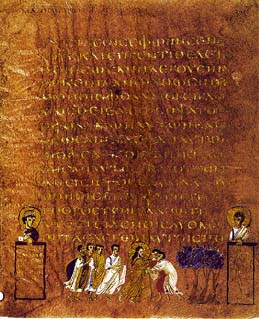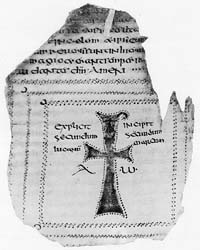New Testament
Contents
Books of the New Testament
The Gospels and Acts:
Pauline Epistles:
- Romans, I Corinthians, II Corinthians, Galatians, Ephesians, Philippians, Colossians, I Thessalonians, II Thessalonians, I Timothy, II Timothy, Titus, Philemon, and Hebrews.
The General Epistles:
And Revelation:
The New Testament is comprised of 27 separate works: the four narratives of Jesus Christ's ministry, called "Gospels"; a narrative of the Apostles' ministries, which is also a sequel to the third Gospel, written by Luke; twenty-one early letters, commonly called "epistles" in Biblical context, which were written by various authors and consisted mostly of Christian counsel and instruction; and an Apocalyptic prophecy, which is also technically the twenty-second epistle.
The Gospels
Each of the Gospels narrates the ministry of Jesus Christ. The traditional author is listed after each entry. Modern scholarship differs on precisely by whom, when, or in what original form the various gospels were written.
- The Gospel of Matthew, traditionally by the Apostle Matthew, son of Alphaeus.
- The Gospel of Mark, traditionally by the Apostle Mark, who wrote down the narrative given by the Apostle Peter.
- The Gospel of Luke, traditionally by the Apostle Luke, who wrote down the narrative given by the Apostle Paul, who was formerly called Saul.
- The Gospel of John, traditionally the Apostle John, son of Zebedee.
Acts
The Acts of the Apostles, also called the Book of Acts or just Acts, is a narrative of the Apostles' ministry after Christ's death and a sequel to the third Gospel. Holy Tradition, as well as style, phraseology, and other evidence, say that Acts and Luke have the same author, the Apostle Luke. Luke wrote down his narrative from the words of the Apostle Paul, with whom he travelled to Rome.
Pauline epistles
The Pauline Epistles constitute those epistles traditionally attributed to Paul, though his authorship of some is disputed (such as Hebrews, which is oft attributed to Paul, though there was a debate even in the Early Church about its authorship). They consist mostly of moral counsel and behavioral instruction, though they do include other elements as well. Paul appears to have dictated the epistles to a scribe and some specifically mention his habit of appending a salutation in his own handwriting.
General epistles
The General or Catholic Epistles are those written to the church at large ("catholic" in this sense simply means "universal").
- Epistle of James, traditionally by James the Just, brother of Jesus and Jude Thomas.
- I Peter and II Peter, traditionally by the Apostle Simon, called Peter.
- I John, II John, and III John, traditionally by the Apostle John, son of Zebedee.
- Jude, traditionally by the Apostle Jude Thomas, brother of Jesus and James.
Prophecy
The Book of Revelation often called just Revelation, traditionally by the Apostle John, son of Zebedee. Revelation is sometimes called The Apocalypse of John. It is the only book of the New Testament which is not read during Orthodox church services, because of various reasons such as its capacity for misinterpretation.
New Testament Apocrypha
In ancient times there were dozens—perhaps hundreds—of Christian writings claiming Apostolic authorship, but which were ultimately rejected by the Church Fathers in the 27-book New Testament canon. These works are considered "apocryphal", and are therefore referred to in singular as the New Testament Apocrypha. The Apocrypha include a large amount of gnostic writings, spurious prophecy, fantasy, and in general a number of other heretical teachings. Below are some examples of early apocryphal works (please note this short list is by no means exhaustive):
- Didache, anonymous instructional text which is considered Orthodox and studied by patristic scholars; written c. AD 50–120.
- Gospel of Thomas - anonymous collection of (Gnostic) sayings attributed to Jesus Christ; written c. AD 50–140.
- Gospel of Peter, anonymous Synoptic narrative; written c. AD 70–160.
- Epistle of Barnabas - anonymous letter of counsel to an unknown audience; written c. AD 80–120.
- Greek Gospel of the Egyptians, anonymous Gospel narrative; written c. AD 80–150.
- Gospel of the Hebrews, anonymous Gospel narrative; written c. AD 80–150.
- First Epistle of Clement, letter of counsel probably composed by Clement, Bishop of Rome, and addressed to the church in Corinth, whose teaching is orthodox but not as worthy of inclusion in the canon as the other epistles; written c. AD 95–96.
- Apocalypse of Peter, anonymous prophecy concerning the end times; written c. AD 100–150.
- The Shepherd of Hermas, anonymous Christian text purportedly by the Apostle Hermas; contains a broad range of content, including prophecy, direct instruction and parables; written c. AD 100–160.
- Gospel of Judas, anonymous gospel narrative attributed to Judas Iscariot; written c. AD 130–170. This "gospel," as well as several of the above like the Shepherd of Hermas, are part of the pseudepigrapha, or writings claiming to be by someone else other than their real author (generally someone more prestigious).
- Protoevangelion of James, a second-century text purported to have been written by James the Just, the brother of the Lord.
Language
The common language spoken in the Holy Land at the time of Jesus was Aramaic. However, the original text of the New Testament was most likely written in Koine Greek, the vernacular dialect in 1st century Roman provinces, and has since been widely translated into other languages, most notably, Latin, Syriac, and Coptic. (However, some of the Church Fathers seem to imply that Matthew was originally written in Hebrew or more likely Aramaic, and there is another contention that the author of the Epistle to the Hebrews wrote in Hebrew, which was translated into Greek by Luke. Neither view holds much support among contemporary scholars, who argue that the literary facets of Matthew and Hebrews suggest that they were composed directly in Greek, rather than being translated.)
It is notable that many books of the New Testament, especially the Gospel of Mark and the Book of Revelation, are written in relatively poor Greek. They are far from the refined Attic Greek or Classical Greek found composed by the higher classes, ruling elites, and trained philosophers of the time. Relative exceptions to this include the gospels of Luke and John and the Acts of the Apostles.

